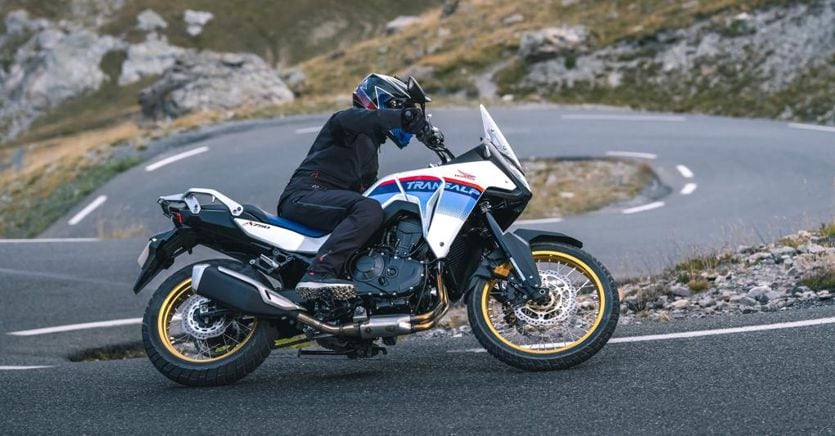Listen to the audio version of the article
The name Transalp evokes fond memories in enthusiasts who have passed the “gate”: the Honda model, presented in 1986, had a 583 cc V-twin and was capable of going anywhere, not just in the imagination of those who bought it who fantasized on the victories in the Paris-Dakar of the powerful Honda Nxr 750 of Cyril Neveu, Gilles Lalay and the Friulian Edi Orioli. Production continued until 2013, when the model went out of production. Ten years later Honda presented the new XL750 Transalp (around 11 thousand euros), always with the same objective: to go everywhere.
Desire for adventure. It may be due to the choice to resume the tricolor color of the first model, but the new Transalp makes you want to leave. The line is simple, slender in the central part, with a large 21″ front wheel (18″ at the rear) with an inner tube that betrays a discreet off-road aptitude: it is not its elective terrain but, if you have to tackle a dirt road , even bad, to get to the isolated beach they told you about in town, it takes you thanks to the 210 mm travel of the Showa fork (190 mm for the rear) and the 200 mm ground clearance.
Engine shared with Hornet. The twin-cylinder, no longer V-shaped but parallel to the front, is the same as the naked: 755 cc and 92 hp of maximum power with a torque of 75 Nm. The electronics differentiate the two versions of the engine: in the Transalp it prefers a character in line with tourist and long-distance use, with four riding modes plus one specific for off-road (Gravel); ABS and traction control can be excluded in the “User” mapping, which can also be customized in the accelerator and engine braking response.
Robust chassis. The skeleton is also in common with the Hornet, but, to better resist the strains of off-road driving, the frame of the Transalp has been stiffened compared to that of the Hornet, while the subframe is wider and longer, in favor of the comfort of the passenger and load capacity. The Nissin braking system includes two 310 mm discs at the front and one 256 mm at the rear. The weight of the Transalp is low: 208 kg in running order (its bigger sister Africa Twin weighs 226).
How is it going. The wide handlebars, the 850 mm high saddle with narrow sides that allow those over 170 cm to rest both feet on the ground give a feeling of safety. The instrumentation is enclosed in a color TFT display that allows you to choose the graphics and can be connected to your smartphone. Unfortunately, some “tourist” equipment is missing: there are not even optional cruise control or windshield adjustment (there isn’t even a knob to adjust the preload of the monoshock absorber); However, it is possible to focus on the larger windscreen, even if the standard one protects even taller riders quite well. The saddle is comfortable, non-sagging, and spacious for the rider and passenger; the clutch is soft, it can be easily managed (the dual-clutch DCT gearbox could arrive in the future): in this way you never get into trouble in traffic, thanks to the limited turning radius. And potholes are easily overcome, with the suspension designed for much more rough terrain. The balance in all conditions is surprising: the Transalp works well in all conditions without ever overdoing it like a specialist motorbike would. Between fast corners, if you exaggerate, it is possible to encounter some load transfer, which is inevitable given the suspension travel. If you proceed cheerfully, but following the DNA of the Transalp, you can travel quickly, always adopting an intuitive ride and confident in the stability of the chassis. As for the twin-cylinder, it shows a verve, above 4 thousand rpm, unknown to the old Transalp: at low speed the thrust is normal, but the medium speeds are vigorous and it extends decisively up to 9 thousand rpm. Some vibrations come from the footpegs, but it must be said that the model we tested was equipped with the Rally Pack kit which includes Quickshifter, engine protection tubes, sump guards, rally footpegs and hand guards with extensions: the absence of rubbers from the footpegs lets some more vibrations pass through. The electronic gearbox, available as an option, convinced us, because it showed no hesitations both when upshifting and downshifting. Off-road, the Gravel riding mode leaves the traction control engaged at minimum and adopts a specific calibration for the ABS: in short, safety is preferred. For the more savvy, there is always the User which removes everything and leaves only the ABS on the front.
